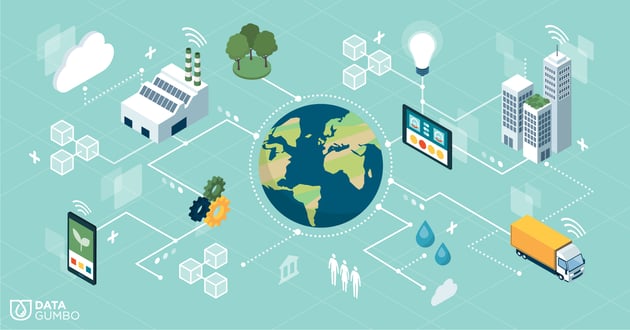Prerequisites For A Low-Carbon Future: Cold, Hard Facts
All eyes turned toward the United States in April this year for President Biden’s Climate Summit and its revelatory declaration to drastically reduce greenhouse gas emissions (GHG) by 50%-52% below 2005 emissions levels before the end of the decade.
Global companies face many challenges ahead, and arguably one of the biggest is the lack of clarity and consistency in environmental, social and governance (ESG) strategies and their reporting of progress. Current practices often hinge on bad data, an approach that exacerbates the disjunction fueling the patchwork of standards against which to measure and report.
One of the world’s greatest management consultants and business educators, Peter Drucker, is often credited with the following quote: “If you can’t measure it, you can’t improve it.” For asset-heavy industries and their supply chains, the quest is on to capture and quantify sustainability data in order to measure, track, improve and then prove traction against carbon reduction targets.
Without a realistic, repeatable and cost-effective way to reach across data silos to access accurate, real-time supply chain information that includes Scope 1, 2 and 3 emissions — the latter being the most critical for a holistic view, but what is also coincidentally the most difficult to achieve — progress toward a low-carbon future will remain hindered. Meanwhile, the deadline for change looms.
Enter Greenwashing
Current ESG methodologies are mired in manual workflows that lean heavily on information culled from spreadsheets, which are vulnerable to human error, manipulation and prone to narrative skewing. The result is inherent indefensibility in a system where each company acts as its own unreliable narrator using unverified information that does little for real-time understanding of impact.
Worse, umbrellaed under the term "greenwashing" is a growing trend where companies and funds issue “misleading claims about their climate risk, progress or ESG credentials,” to sway capital or public opinion in their favor. As of late, several high-profile greenwashing cases have heightened scrutiny and attention on the matter, and in an effort to crack down and police climate risk disclosures, the Security Exchange Commission (SEC) set up a task force in early spring to specifically target fraudulent claims.
Part of what enables greenwashing practices is a lack of transparency or standardization in the collection, calculation and reporting of ESG data — and in the ability to harvest accurate data in and of itself across a supply chain into Scope 3 emissions. The conundrum surrounding ESG is that the path to net zero is a forward-looking endeavor, but the data being used to get there is either based on estimates, based on narrative accounts or stuck in disparate information systems — all practices of the past. What’s missing most from the current ESG equation is cold, hard and accurate data.
Definitive Insights Are Possible
If investors, regulatory agencies, customers and society at large desire definitive proof of corporate ESG improvements, a new approach to sustainability impact data must be taken. For financial records, general ledgers are subject to audits as a system of record, but the same isn’t true for ESG data and supporting carbon reduction claims — that is, unless ESG data is collected with smart contracts and married to a blockchain.
Blockchain can be used to back smart contracts that automate commercial counterparty transactions. And unlike a spreadsheet, the data cannot be unilaterally changed since ledgers are distributed across participants in the value chain. By accessing and aggregating operational field data and industrial internet of things (IIoT) connected devices (e.g., sensors, meters, drones, etc.), smart contracts reach across disparate data sources to create an immutable record that captures real-world physical events and services as they occur. This data is then used to trigger automatic payments based on unchangeable shared records corroborating that pre-agreed contract terms have been satisfied.
This same functionality of blockchain-powered smart contracts can also harvest sustainability impact data across a company’s entire supply chain resulting in a new, transparent way to capture high-quality ESG data and create accurate and audible ESG records yielding the cold hard facts required to make better decisions. As international legal frameworks and standards bodies form architectures to address the current vague, inconsistent reporting landscape, those companies looking to dial in on their ESG targets must decipher realistic ways to reliably and repeatedly digest true environmental impact at speed and with transparency. Blockchain is proven in this capacity for smart contracts, and now it is time for this same technology to gather Scope 1, 2, and 3 emissions data and other ESG metrics.
Delivering On Promises
To get started with blockchain, select a vendor or customer from across a supply chain and reach out to them to coordinate on sharing ESG data — consider items like mileage data from trucking vendors or fuel deliveries tracked with sensors or meters. Be it Scope 1, 2 or 3 data, examining what information is already being collected in a palatable format can help decide where to dig in to deploy smart contracts.
As the SEC buckles down and the Biden administration maintains pace on climate change, blockchain is on deck to move global companies beyond the sticking point of quality ESG data. Not only does it offer a way to access Scope 1, 2 and 3 data, but it also provides the accuracy sorely needed for companies to work toward creating a low-carbon future predicated on facts.
--
This article, authored by Andrew Bruce, originally appeared at Forbes Technology Council.



